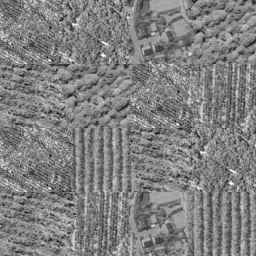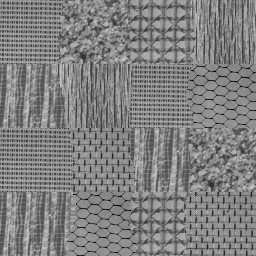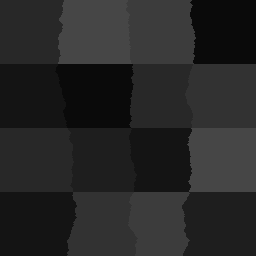
P1: Patches from real aerial images.
They represent fields, forests, and
a residential area
Texture analysis research has been suffering from the lack
of common test images
on which the algorithm performances are illustrated, specially so for unsupervised
image segmentation using texture features. Here we attempt to decrease
this difficulty of comparison by providing a set of test pictures. The idea
is
to have few but sufficiently difficult real textures with known
texture boundaries as test images. Automatic segmentation algorithms can
then
provide their results on these images which can be compared
with published results (on the same images) without that each author needs
to
implement other authors algorithms.
The texture patches in this web site were constructed by
J. Bigun and J.M.H. du Buf in 1989, when both were working
at the Swiss Federal Institute of Technology, Lausanne. In the particular
choice of the texture patches, 3 independent human experts were constulted.
The images are in 4x4 patches. Only 7 different textures exist though.
They are repeated in such a way that every texture is a neighbor of
another at least once. Every patch is photometrically normalized
by the function a*f+b, where f is the pixel (gray) value, so that
all patches have the same mean and variance. The vertical
boundaries consist of three random walks and
the x-coordinates of the vertical boundaries are given in the file
border.tex (see below).
All images are 256x256 with 1 unsigned byte per pixel (gif format).

P1:
Patches from real aerial images.
They represent fields, forests, and
a residential area

P2:
Patches from real aerial images.
They represent fields and forest.

P3:
Patches originally photographed
by Brodatz, (see reference [5] below)
but arranged and normalized as in P1 and P2.

answer:
The answer image displaying
the patch identities with unique gray levels.
All patch images are arranged according to this
file. The same gray levels represent the same textures.
For humans, it is easiest to see this image
with a false color map. It can be seen that
the vertical borders are random walks whereas
the horizontal borders are straight lines.
border.tex
(ascii file to be down loaded) Vertical boundary locations, that are realizations
of three separate random walks. In this file there are exactly 256 rows
with three numbers in each. The first row of these triplets represents the
x coordinates of the three borders separating the four texture patches in
the first row of the pixels of the image (see answer.gif above). The second
row of the triplets is the x coordinates of the three separating borders in
the second row ..etc.
Published automatic texture segmentation results that use these images,
include the references [1]-[4]:
COPYRIGHT
All rights of P1 and P2 images belong to the authors (above).
However, in an unaltered form, these images can be used and published
in scientific contexts e.g journal articles, conference articles ...etc
freely provided that the origin of the images is indicated at the caption
(where
these images appear). Citing Refererence [1] below is an acceptable way
of
doing this e.g. by including something like "The patch image is constructed
by
Bigun & du Buf, see [Reference]" in the caption. Even commercial products
can use them provided that the origin is indicated. An acceptable way of
doing
this is putting these images in the same directory as with the README
file.
The use of P3 in scientific publications, as far as the above authors'
added value is concerned, is granted freely, provided that the origin
is cited in the same way as the P1 and the P2 images.
REFERENCES
[1]
@Article{bigun94pami2,
author = "J. Bigun and J. M. H.\ du Buf",
title = {N-folded symmetries by
complex moments in {G}abor space},
journal = "IEEE-PAMI",
pages = "80--87",
volume = "16",
number = "1",
year = "1994",
OPTannote= { %old key bigun91pami2
%old key bigun93pami2
},
}
[2]
@article{Bigun92sgproc,
Author = {J. Bigun},
Title = {Frequency And
Orientation Sensitive Texture Measures Using Linear Symmetry},
Journal = { Signal Processing},
Year = {1992},
Volume = {29},
Pages = {1-16},
Optannote = { %Old Key Bigun90sgproc}
}
[3]
@Article{bigun91pami,
author = "J. Bigun and G. H. Granlund and J. Wiklund",
title = "Multidimensional Orientation Estimation with
Applications to Texture Analysis and Optical Flow",
journal = "IEEE-PAMI",
pages = "775--790",
volume = "13",
number = "8",
month = aug,
year = "1991",
annote= { Report LiTH-ISY-I-0828 1986 and Report LiTH-ISY-I-1148 1990,
both at Computer Vision Laboratory, Linköping University, Sweden}
}
[4]
@Article{schroeter95pr,
author = {P. Schroeter and J. Bigun},
title = {Hierarchical image segmentation by multi-dimensional
clustering and orientation adaptive boundary refinement},
journal = { Pattern
Recognition},
year = {1995},
volume = {28},
number = {5},
pages = {695-709},
OPTannote = {}
}
[5]
@Book{brodatz,
author = {P. Brodatz},
title = {Textures},
publisher = {Dover
publications, Inc.},
year = {1966},
address = {New York},
OPTannote = {}
}